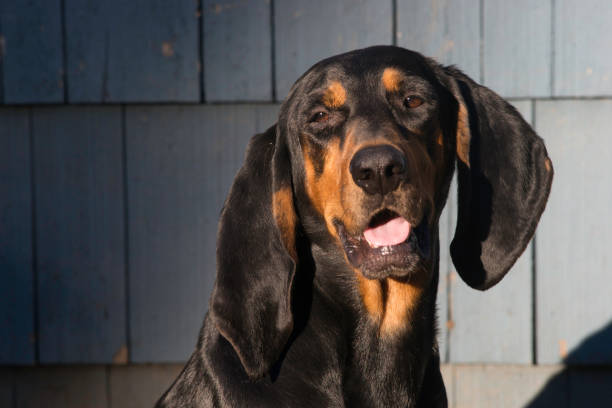Black and Tan Coonhound

Breed History:
The Black and Tan Coonhound is a distinctly American breed developed in the United States during the 18th and 19th centuries. Bred from the Foxhound and the Bloodhound, it was designed specifically to track and tree raccoons in difficult terrain and during nighttime hunts.
Its excellent nose, endurance, and loud bay made it ideal for hunters in the Southern U.S. The breed became the first coonhound recognised by the AKC in 1945. While still used for hunting, it is also appreciated today as a loyal companion.
|
Gender |
Height |
Weight |
|
Male |
63-69 cm |
34-45 kg |
|
Female |
58-64 cm |
29-40 kg |
Size: Large
Life Expectancy: 10–12 years

Breed Appearance:
The Black and Tan Coonhound is a large, powerful dog with a deep chest, strong legs, and a long, narrow head. It has long, pendulous ears, loose skin, and dark brown to hazel eyes with a soulful expression.
The short, dense coat is always black with rich tan markings, particularly above the eyes, on the muzzle, chest, legs, and underside of the tail. Its tail is carried high with a slight curve, especially when alert or excited.
Breed Type – Scent Hound:
This breed is a true scent hound, known for its ability to track scents over miles with great determination. It’s methodical, patient, and single-minded on the trail.
At home, it is laid-back, friendly, and loyal, though it retains a strong prey drive and a loud, baying bark. This makes it unsuited to urban environments or close neighbours.

Training:
The Black and Tan Coonhound is intelligent but independent, often more motivated by scent than commands. Training must be consistent, patient, and reward-based.
Early socialisation and obedience training help prevent excessive barking, stubbornness, and pulling on the leash. While eager to please at times, their tracking instinct can override obedience when outdoors.
Health & Care:
Generally healthy, but may be prone to:
-
Hip dysplasia
-
Ear infections (due to long ears)
-
Bloat (gastric torsion)
-
Eye issues like ectropion
Regular checkups, ear cleaning, and avoiding vigorous exercise before or after meals can help. Maintaining a healthy weight is also crucial for joint support.

Living Conditions:
This breed is best suited to homes with large, securely fenced yards. Apartment life is possible only with ample exercise and tolerance for loud vocalisations.
They are happiest with space to roam and sniff, and a home where barking isn’t a problem. The breed gets along well with respectful children and other dogs but may chase smaller animals.
Exercise:
While calm indoors, the Coonhound needs daily activity to stay fit and mentally balanced:
-
Long daily walks or jogs
-
Tracking games or scent work
-
Hiking or hunting excursions
-
Access to a safe, fenced area for roaming
Always use a leash or secure enclosure, as their nose may lead them far from home.
Grooming:
Grooming needs are modest:
-
Weekly brushing to manage loose hairs
-
Clean your ears regularly to prevent infections
-
Wipe drool and eye discharge as needed
-
Routine nail trims and dental care
They shed moderately year-round and may have a houndy odour if not cleaned regularly.

Advantages:
-
Excellent scent-tracking and hunting skills
-
Friendly, even-tempered, and good with kids
-
Relatively low grooming needs
-
Hardy and adaptable to outdoor life
-
Loyal and laid-back at home
-
Rare, distinctive American breed
Disadvantages:
-
Loud baying is not neighbour-friendly
-
Strong prey drive—may not be safe off-leash
-
Can be stubborn and independent
-
Prone to ear infections and bloat
-
Needs a lot of exercise and mental stimulation
-
Not ideal for small homes or inactive owners

